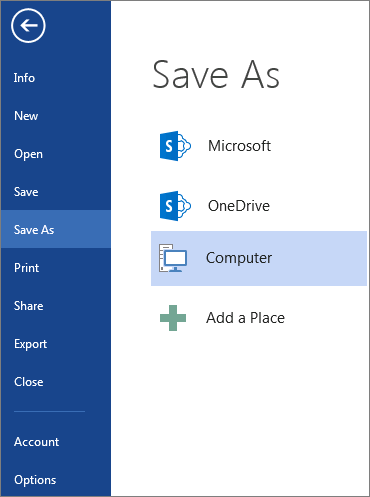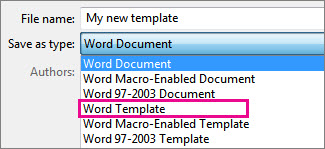Excel for Microsoft 365 Word for Microsoft 365 PowerPoint for Microsoft 365 Access for Microsoft 365 Excel for Microsoft 365 for Mac Word for Microsoft 365 for Mac PowerPoint for Microsoft 365 for Mac Word for the web Excel 2021 Word 2021 PowerPoint 2021 Access 2021 Visio Standard 2021 Excel 2021 for Mac Word 2021 for Mac PowerPoint 2021 for Mac Excel 2019 Word 2019 PowerPoint 2019 Access 2019 Visio Standard 2019 Excel 2019 for Mac Word 2019 for Mac PowerPoint 2019 for Mac Excel 2016 Word 2016 PowerPoint 2016 Access 2016 Visio Standard 2016 More. Less
If you frequently create a certain type of document, such as a monthly report, a sales forecast, or a presentation with a company logo, save it as a template so you can use that as your starting point instead of recreating the file from scratch each time you need it. Start with a document that you already created, a document you downloaded, or a new Microsoft template you customized.
For a basic template, click the template item in the Save as type list. In Word for example, click Word Template.
Tip: To change where your application automatically saves your templates, click File > Options > Save and type the folder and path you want to use in the Default personal templates location box. Any new templates you save will be stored in that folder, and when you click File > New > Personal, you'll see the templates in that folder.
Edit your template
To update your template, open the file, make the changes you want, and then save the template.
- Click File >Open.
- Double-click Computer or This PC.
- Browse to the Custom Office Templates folder that’s under My Documents.
- Click your template, and click Open.
- Make the changes you want, then save and close the template.
Use your template to make a new document
To start a new file based on your template, click File > New > Custom, and click your template.
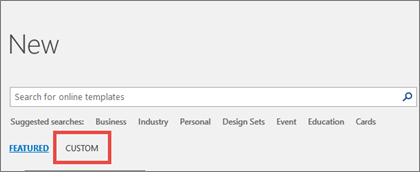
Note: If you're using Office 2013, this button may say Personal instead of Custom.
Use your templates from earlier versions of Office
If you made templates in an earlier version of Office, you can still use them in Office 2013 and 2016. The first step is to move them into the Custom Office Templates folder so your application can find them. To move your templates quickly, use the Fix it tool.
Word
Save a document as a template
- Open the Word document that you want to save as a template.
- On the File menu, click Save as Template.
- In the Save As box, type the name that you want to use for the new template.
- (Optional) In the Where box, choose a location where the template will be saved.
- Next to File Format, click Microsoft Word template (.dotx), or, if your document contains macros, click Microsoft Word Macro-Enabled template (.dotm).
- Click Save. Unless you select a different location, the template is saved in /Users/username/Library/Group Containers/UBF8T346G9.Office/User Content/Templates. To change where Word automatically saves your templates, on the Word menu, click Preferences, and then under Personal Settings, click File Locations. Under File Locations, select User templates from the list, and then click Modify. Type the new folder and path you want to use, and Word will save any new templates in that folder.
Create a new template based on another template
You can customize an existing template to make it even more useful. Add static information to the existing template, and then save the file again (as a template).
- On the File menu, click New from Template.
- Click a template that is similar to the one you want to create, and then click Create.
Note: If you can't find a template, you can search for it based on keywords in the Search All Templates box.
Use your template to create a new document
To start a new document based on your template, on the File menu, click New from Template, and then select the template you want to use.
Delete a template
- In the Finder, open /Users/username/Library/Group Containers/UBF8T346G9.Office/User Content/Templates.
- Drag the templates that you want to delete to the Trash.
PowerPoint
Create a PowerPoint template
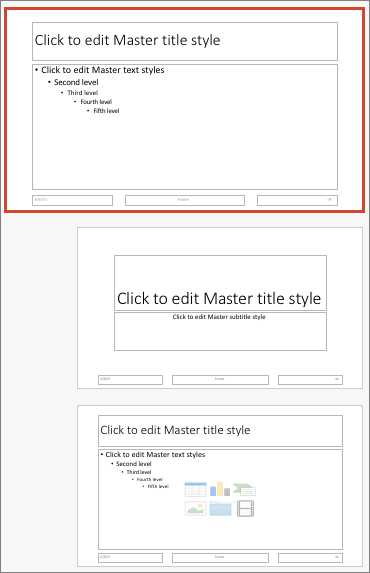
- Open a blank presentation, and then on the View tab, click Slide Master. The slide master is the largest slide image at the top of the slide thumbnail list. Associated layouts are positioned beneath it.

To make changes to the slide master or layouts, on the Slide Master tab, do any of these:
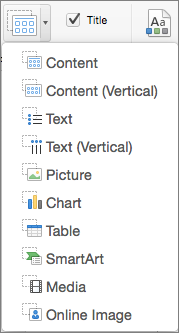
- To add a colorful theme with special fonts, and effects, click Themes, and pick a theme.
- To change the background, click Background Styles, and pick a background.
- To add a placeholder for text, picture, chart, and other objects, in the thumbnail pane, click the slide layout that you want to hold the placeholder. From Insert Placeholder, pick the type of placeholder you want to add, and drag to draw the placeholder size.
Save your presentation as a PowerPoint template
- Open the presentation that you want to save as a template.
- On the File tab, click Save as Template.
- In the Save As box, type the name that you want to use for the new template.
- (Optional) In the Where box, choose a location where the template will be saved.
- Next to File Format, click PowerPoint Template (.potx), or, if your presentation contains macros, click PowerPoint Macro-Enabled Template (.potm).
- Click Save. Unless you select a different location, the template is saved in /Users/username/Library/Group Containers/UBF8T346G9.Office/User Content/Templates.
Create a new template based on another template
You can customize an existing template to make it even more useful. Add static information to the existing template, and then save the file again (as a template).
- On the File menu, click New from Template.
- Click a template that is similar to the one you want to create, and then click Create.
Note: If you can't find a template, you can search for it based on keywords in the Search All Templates box.
Use your template to create a new presentation
To start a new presentation based on a template, on the File menu, click New from Template, and then select the template you want to use.

